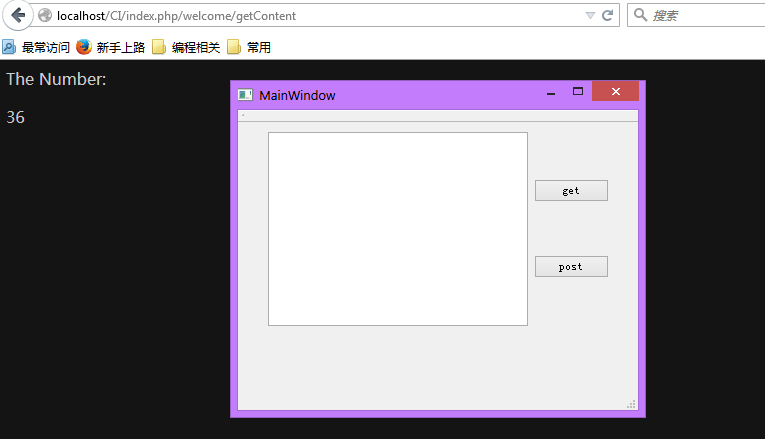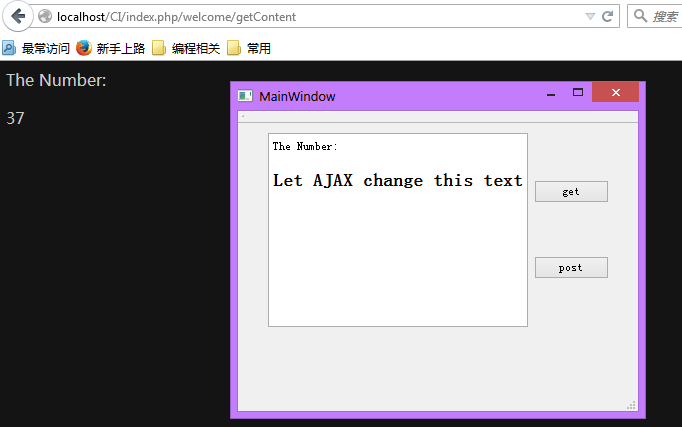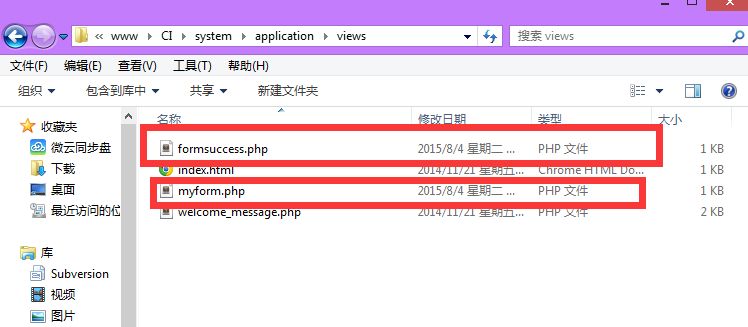QT中使用QNetworkAccessManager类进行POST数据
QNetworkAccessManager类简介:
QNetworkAccessManager类允许应用程序发送网络请求和接收网络应答。
Network Access API都是围绕着一个QNetworkAccessManager对象构造的,这个对象包含着发送请求的一些通用配置和设置。它包含着代理和缓存的配置,以及和这些事物相关的一些信号,并且应答信号可以作为我们检测一个网络操作的进度。
一个QNetworkAccessManager对于一整个Qt应用程序来说已经足够了!
一旦一个QNetworkAccessManager对象被创建了,那么应用程序就可以使用它在网络上发送请求。它提供了一组标准的函数,可以承载网络请求和一些可选的数据,并且每一个请求返回一个QNetworkReply对象。该返回的对象包含着返回的请求应带的所有数据。
本例使用POST向网站页面传递数据,HTTP传输数据主要有两种形式,分别是Get和POST,两者的详细的介绍请参见[这里](http://blog.csdn.net/yipiankongbai/article/details/24025633)。
本例运行的最终效果图如下
实现的功能是:
点击POST按钮,发送一个数据,并把这个数据写入数据库,网页上显示的是当前数据库中的数据条数。显示数据采用AJAX,可以在固定的时间间隔内自动刷新获得数据(通过不断的向服务器发送GET请求实现。这样写对服务器的压力比较大,我这里主要是为了演示POST的使用方法,实际中不采用这种不断GET的方法)。
QT的代码如下:
//QT的工程文件
#-------------------------------------------------
#
# Project created by QtCreator 2015-08-04T14:40:58
#
#-------------------------------------------------
QT += core gui
greaterThan(QT_MAJOR_VERSION, 4): QT += widgets
TARGET = networkTest
TEMPLATE = app
SOURCES += main.cpp\
mainwindow.cpp
HEADERS += mainwindow.h
FORMS += mainwindow.ui
QT+=network
//mainwindow.h
#ifndef MAINWINDOW_H
#define MAINWINDOW_H
#include <QMainWindow>
#include <QNetworkReply>
#include <QNetworkRequest>
#include<windows.h>
namespace Ui {
class MainWindow;
}
class MainWindow : public QMainWindow
{
Q_OBJECT
public:
explicit MainWindow(QWidget *parent = 0);
~MainWindow();
public slots:
void finishedSlot(QNetworkReply *reply);
void onClicked();
void onClickedPost();
private:
Ui::MainWindow *ui;
QNetworkAccessManager *nam;//定义变量
};
#endif // MAINWINDOW_H
//main.c
#include "mainwindow.h"
#include <QApplication>
int main(int argc, char *argv[])
{
QApplication a(argc, argv);
MainWindow w;
w.show();
return a.exec();
}
//mainwindow.cpp
#include "mainwindow.h"
#include "ui_mainwindow.h"
#include<QHttp>
MainWindow::MainWindow(QWidget *parent) :
QMainWindow(parent),
ui(new Ui::MainWindow)
{
ui->setupUi(this);
nam=new QNetworkAccessManager(this);
connect(ui->pushButton_get,SIGNAL(clicked()),this,SLOT(onClicked()));
connect(nam, SIGNAL(finished(QNetworkReply*)),
this, SLOT(finishedSlot(QNetworkReply*)));
connect(ui->pushButton_post,SIGNAL(clicked()),this,SLOT(onClickedPost()));
}
MainWindow::~MainWindow()
{
delete ui;
}
void MainWindow::finishedSlot(QNetworkReply *reply)
{
#if 1
// Reading attributes of the reply
// e.g. the HTTP status code
QVariant statusCodeV =
reply->attribute(QNetworkRequest::HttpStatusCodeAttribute);
// Or the target URL if it was a redirect:
QVariant redirectionTargetUrl =
reply->attribute(QNetworkRequest::RedirectionTargetAttribute);
// see CS001432 on how to handle this
// no error received?
if (reply->error() == QNetworkReply::NoError)
{
QByteArray bytes = reply->readAll(); // bytes
//QString string(bytes); // string
QString string = QString::fromUtf8(bytes);
ui->textBrowser->setText(string);
}
else
{
// handle errors here
}
// We receive ownership of the reply object
// and therefore need to handle deletion.
reply->deleteLater();
#endif
}
void MainWindow::onClicked()
{
QUrl url("http://www.hust.edu.cn/");
nam->get(QNetworkRequest(url));
}
void MainWindow::onClickedPost()
{
//QUrl url("http://www.hust.edu.cn/");
//QUrl url("http://www.google.com/ig/api?weather=wuhan");
// QHttp re;
// QHttpRequestHeader request_header;
QNetworkRequest request;
QUrl url("http://localhost/CI/index.php/welcome/getdata");
QByteArray data;
data.append("name=admin&");
data.append("email=weihao");
// request.setHeader(QNetworkRequest::ContentLengthHeader, data.length());
request.setUrl(url);
request.setRawHeader("Content-Type","application/x-www-form-urlencoded");
// QByteArray append("name=admin&email=123456");
//QNetworkReply* reply = nam->get(QNetworkRequest(url));
QNetworkReply* reply = nam->post(request, data);
// NOTE: Store QNetworkReply pointer (maybe into caller).
// When this HTTP request is finished you will receive this same
// QNetworkReply as response parameter.
// By the QNetworkReply pointer you can identify request and response.
}
//mainwindow.ui
<?xml version="1.0" encoding="UTF-8"?>
<ui version="4.0">
<class>MainWindow</class>
<widget class="QMainWindow" name="MainWindow">
<property name="geometry">
<rect>
<x>0</x>
<y>0</y>
<width>400</width>
<height>300</height>
</rect>
</property>
<property name="windowTitle">
<string>MainWindow</string>
</property>
<widget class="QWidget" name="centralWidget">
<widget class="QWidget" name="layoutWidget">
<property name="geometry">
<rect>
<x>30</x>
<y>10</y>
<width>341</width>
<height>194</height>
</rect>
</property>
<layout class="QHBoxLayout" name="horizontalLayout">
<item>
<widget class="QTextBrowser" name="textBrowser"/>
</item>
<item>
<layout class="QVBoxLayout" name="verticalLayout">
<item>
<widget class="QPushButton" name="pushButton_get">
<property name="text">
<string>get</string>
</property>
</widget>
</item>
<item>
<widget class="QPushButton" name="pushButton_post">
<property name="text">
<string>post</string>
</property>
</widget>
</item>
</layout>
</item>
</layout>
</widget>
</widget>
<widget class="QMenuBar" name="menuBar">
<property name="geometry">
<rect>
<x>0</x>
<y>0</y>
<width>400</width>
<height>20</height>
</rect>
</property>
</widget>
<widget class="QToolBar" name="mainToolBar">
<attribute name="toolBarArea">
<enum>TopToolBarArea</enum>
</attribute>
<attribute name="toolBarBreak">
<bool>false</bool>
</attribute>
</widget>
<widget class="QStatusBar" name="statusBar"/>
</widget>
<layoutdefault spacing="6" margin="11"/>
<resources/>
<connections/>
</ui>
以上是QT客户端代码。服务器端我使用的CI的框架,如果不清楚这个的话直接百度,上面有详细的讲解。不过本例的实现与这个CI框架无关,只是个人使用习惯。(代码是按照CI框架的结构来写的)

其他的文件与本例无关,可以直接忽略。主要是画红线的文件。
//welconme.php
<?php if ( ! defined('BASEPATH')) exit('No direct script access allowed');
class Welcome extends CI_Controller {
public function index()
{
$this->load->view('myform');
}
public function getdata()
{
$temp=new common_m('content','data');
$data['content'] =$_POST['name'];
// $this->load->view('formsuccess');
$this->getContent();
$temp->insert($data);
}
public function getnum()
{//这里是使用数据库的语句,具体的用法可以CI的modles文件夹中找 //到这个common_m.php的文件,里面有详细的用法。
$temp=new common_m('content','data');
echo $temp->_all_num();
}
public function getContent()
{
$this->load->view('formsuccess');
}
}
/* End of file welcome.php */
/* Location: ./application/controllers/welcome.php */视图中的文件
//myform.php
<html>
<head>
<title>My Form</title>
</head>
<body>
<form action="welcome/getdata" method="post">
Name: <input type="text" name="name"><br>
E-mail: <input type="text" name="email"><br>
<input type="submit">
</form>
</body>
</html>//formsuccess.php
<html>
<head>
<title>My Form</title>
<script type="text/javascript">
function loadXMLDoc()
{
var xmlhttp;
if (window.XMLHttpRequest)
{// code for IE7+, Firefox, Chrome, Opera, Safari
xmlhttp=new XMLHttpRequest();
}
else
{// code for IE6, IE5
xmlhttp=new ActiveXObject("Microsoft.XMLHTTP");
}
xmlhttp.onreadystatechange=function()
{
if (xmlhttp.readyState==4 && xmlhttp.status==200)
{
document.getElementById("myDiv").innerHTML=xmlhttp.responseText;
}
}
//写出完整路径,获取要显示的数据
xmlhttp.open("GET","http://localhost/CI/index.php/welcome/getnum",true);
xmlhttp.send();
//每隔1秒中更新一下数据
setTimeout("loadXMLDoc()", 1000);
}
</script>
</head>
<body>
<p>The Number:</p>
<div id="myDiv"><h2>Let AJAX change this text</h2></div>
<!-- <button type="button" onclick="loadXMLDoc()">通过 AJAX 改变内容</button> -->
<script type="text/javascript">loadXMLDoc();</script>
</body>
</html>
以上就是这个例子的介绍。有不足的地方,欢迎大家进行指正(∩_∩)。附上代码包下载链接http://download.csdn.net/detail/a_a_ron/8960635



























 2407
2407

 被折叠的 条评论
为什么被折叠?
被折叠的 条评论
为什么被折叠?








